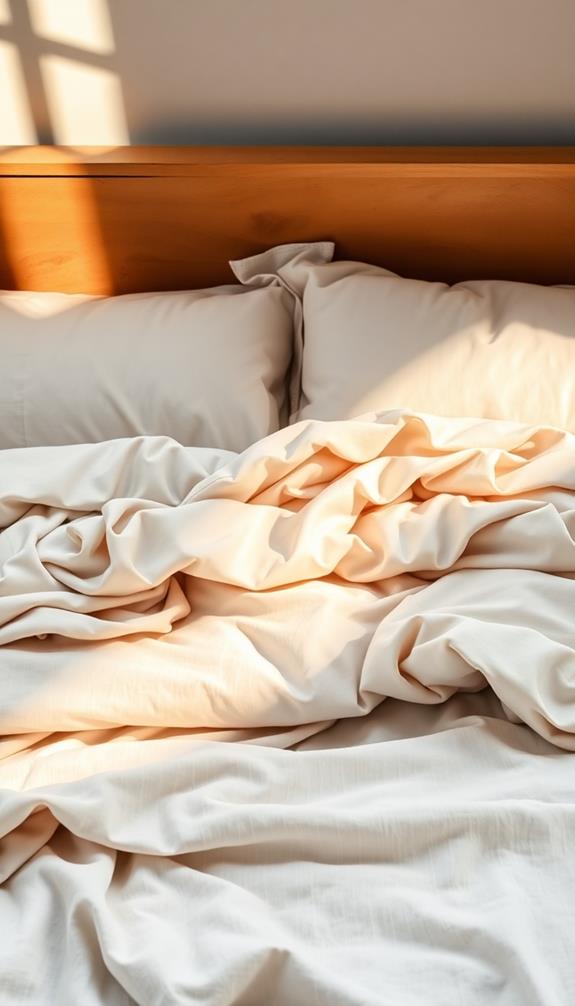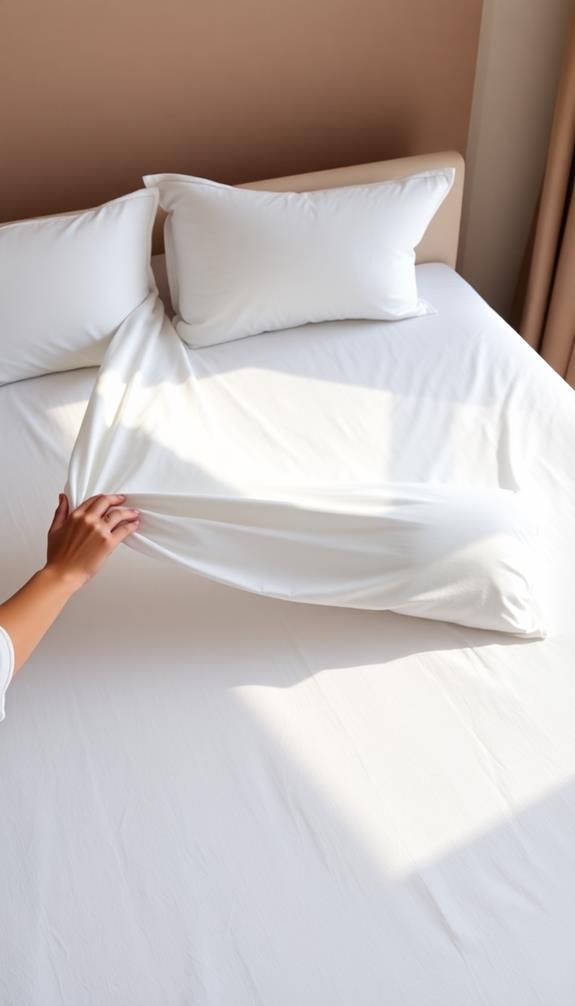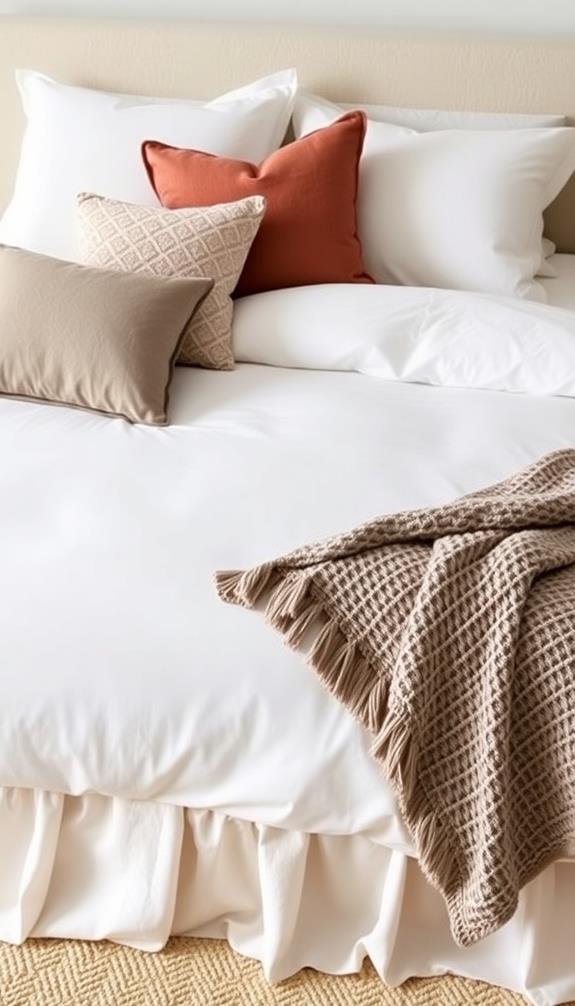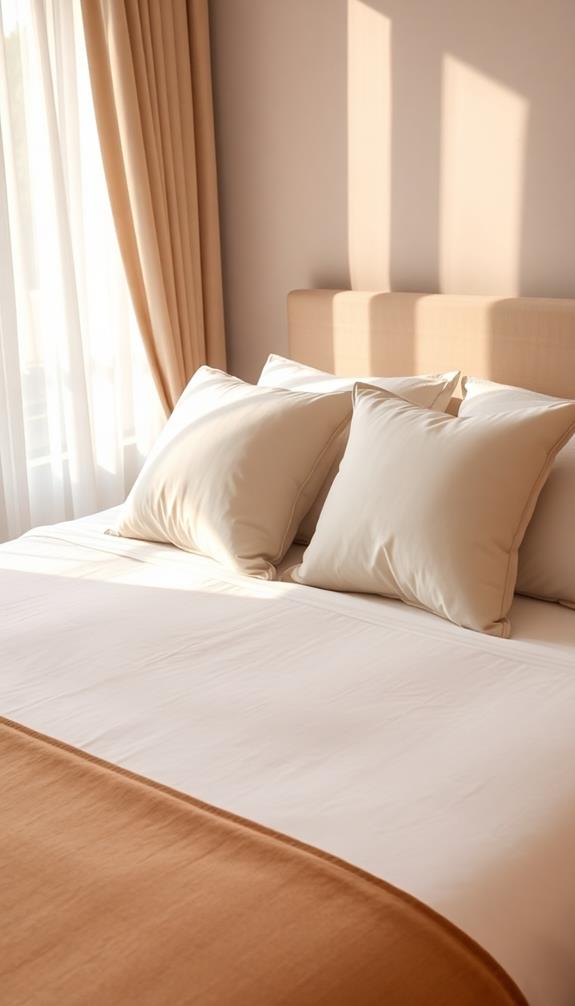To put a flat sheet on your bed, start by laying it evenly over the mattress. Make sure the top edge aligns with the head of the mattress. Tuck the bottom part securely between the mattress and the box spring to keep it in place. For a polished look, fold the sides under the mattress and create hospital corners by tucking excess fabric neatly. Smooth out any wrinkles for a crisp finish. Layer it with your favorite blankets or comforters for added warmth and style. There's plenty more to contemplate for an inviting bed setup.
Overview of Bed Sheets
When it comes to bedding, understanding the different types of sheets is essential for a good night's sleep. You'll typically find bed sheets categorized into fitted sheets and flat sheets, each serving a unique purpose.
Fitted sheets come with elastic edges that hug your mattress tightly, ensuring they stay in place as you move during the night. This snug fit provides a solid layer of protection for your mattress while enhancing your comfort. Additionally, opting for sustainable bed linens can enhance your sleeping environment by ensuring that your bedding is free from harmful chemicals, promoting better health and well-being.
On the other hand, flat sheets are versatile and rectangular, offering more flexibility in how you use them. You can lay a flat sheet on top of your fitted sheet for added comfort or tuck it securely under the mattress for a neat finish.
Pairing your sheets with matching pillowcases not only improves aesthetics but also contributes to a cohesive bedroom decor.
The fabric you choose—whether it's cotton, bamboo, or synthetic fibers—greatly influences your overall sleep quality and maintenance routines. Understanding these distinctions in bed sheets helps you create an inviting and restful sleeping environment, ensuring you wake up refreshed and ready to take on the day.
Types of Flat Sheets
What types of flat sheets suit your sleeping preferences? Flat sheets are versatile, serving as either a top sheet or a bottom sheet, and they come in various materials, each enhancing your comfort and overall bedding experience.
Choosing natural materials can also contribute to a healthier sleeping environment, promoting better indoor air quality and overall well-being, as highlighted by the benefits of natural cleaning solutions.
Here are three popular options:
- Cotton: Known for its breathability and softness, cotton flat sheets provide comfort year-round, allowing for excellent temperature regulation.
- Bamboo: These flat sheets are eco-friendly and moisture-wicking, making them perfect for those who sweat at night while still being gentle on the skin.
- Linen: Ideal for warmer climates, linen flat sheets offer a relaxed feel and excellent airflow, ensuring you stay cool during hot nights.
Using flat sheets not only enhances comfort but also protects your blankets and duvets from wear and tear, keeping them fresher for longer.
Plus, their ease of storage makes seasonal bedding changes a breeze. You'll appreciate the ability to adjust layers of bedding according to your comfort needs, whether it's a chilly night or a warm summer evening.
Material Considerations

Choosing the right material for your flat sheet can greatly impact your comfort and sleep quality. Flat sheets can be crafted from various materials, including Egyptian cotton, bamboo, and synthetic fibers. Each material offers different benefits regarding breathability, comfort, and durability, which are vital for guaranteeing a comfortable, luxurious sleep experience.
When selecting your flat sheet, consider the thread count. A higher thread count, typically 300 or more, indicates a softer texture and higher quality. Egyptian cotton is particularly renowned for its softness and longevity, making it a preferred choice for everyday use.
You'll also want to pay attention to the weave of the fabric. Percale weave is known for its crisp feel and durability, while sateen weave provides a softer, more luxurious touch, catering to different comfort preferences.
If you're environmentally conscious, eco-friendly materials like bamboo fibers not only support sustainability but also offer excellent breathability and moisture-wicking properties.
Ultimately, choosing the right materials for your flat sheets guarantees a comfortable and restful night's sleep, setting the foundation for a perfectly made bed.
Benefits of Flat Sheets
Flat sheets offer a range of benefits that enhance your overall sleep experience. They serve as an additional layer for warmth during colder months or a lightweight covering during warmer weather.
Additionally, using flat sheets can contribute to a healthier sleeping environment by reducing allergens and irritants, much like how non-toxic cleaners promote a safer home.
Here are three key advantages of using flat sheets:
- Protective Barrier: Flat sheets act as a protective barrier for your duvet or blanket, keeping them clean from bodily fluids and reducing washing frequency. This helps maintain bedding cleanliness, so you can enjoy a fresh sleeping environment.
- Easier to Wash: Compared to duvet covers, flat sheets are easier to wash and fold. This practicality saves you time and effort in maintaining your bedding.
- Comfort & Temperature Regulation: Flat sheets create a softer surface against your skin, enhancing your comfort while you sleep. Layering them with other bedding items allows for better temperature regulation, contributing to a more restful night.
Step-by-Step Bed Making

To make your bed look neat and inviting, start by laying the flat sheet evenly over the mattress. Guarantee the sides hang down equally to create a balanced appearance. For best results, smooth out wrinkles before folding the sheet to enhance the overall aesthetic.
Next, tuck the bottom end of the flat sheet securely between the mattress and the box spring at the foot of the bed. This step prevents it from coming loose during the night.
Now, fold the sides of the flat sheet neatly under the mattress. This guarantees a snug fit that eliminates excess fabric and promotes a tidy look.
For an added touch of professionalism, create hospital corners at the foot of the bed. Tuck the sheet under the mattress, folding the excess fabric neatly for a crisp finish.
Layering Techniques
When it comes to layering your flat sheet, proper placement is key for a neat appearance.
Regularly changing your bed linens every 1-2 weeks can help maintain a fresh and hygienic sleeping environment, which complements the overall aesthetic of a well-made bed.
You'll want to secure the sheet with tucking methods that keep everything in place, especially at the foot of the bed.
Finally, adding a cozy blanket or duvet on top enhances comfort while creating an inviting look.
Consider the importance of changing bed linens for improved sleep quality and hygiene.
Proper Sheet Placement
Achieving a polished look with your bedding starts with the proper placement of your flat sheet. Begin by laying the flat sheet evenly over the mattress, with the finished side facing down. Let the extra length hang over the sides for a neat appearance.
Here's how to guarantee perfect placement:
- Tuck the bottom end: Securely tuck the bottom end of the flat sheet between the mattress and box spring at the foot of the bed. This creates a clean line and sets a solid foundation.
- Check the sides: Make sure the lengths on both sides of the flat sheet are equal. This balance prevents any unevenness once you start tucking the sides under the mattress.
- Use hospital corners: For a tidy finish, fold the sheet over the corner of the mattress and tuck the excess fabric neatly underneath. This technique not only looks professional but also keeps your flat sheet in place.
Once you've positioned the flat sheet, you can layer a blanket or duvet on top, aligning the top edge with the mattress for an inviting look.
Secure Tucking Methods
Once your flat sheet is properly placed and secured, the next step is to focus on tucking methods that keep everything in order.
Start by ensuring the flat sheet lays evenly over the mattress, with equal lengths hanging on each side. This creates a smooth surface without wrinkles. Align the top edge of the flat sheet with the top of the mattress, allowing the remaining fabric to drape down the sides for easy tucking.
For a neat finish, use hospital corners. Tuck the excess fabric at the corners of the mattress neatly under, giving it a crisp, professional look while securing the sheet in place.
At the foot of the bed, tuck the bottom end of the flat sheet securely between the mattress and box spring. This enhances stability and prevents movement during sleep.
Layering for Comfort
Layering your bedding not only enhances comfort but also adds a touch of style to your bedroom.
Begin with your flat sheet, placing it face down with the top edge aligned with the mattress. This allows the side edges to hang evenly, giving a neat appearance. Tuck the bottom edge securely between the mattress and box spring for a smooth surface.
Don't forget to utilize hospital corners for a polished look—this technique minimizes movement during sleep and keeps everything in place.
Next, consider these layering techniques for added comfort:
- Mattress Pad: Place a mattress pad under the flat sheet to enhance softness and protect against spills and allergens.
- Blanket: Layer a cozy blanket on top of the flat sheet, giving you extra warmth.
- Duvet: Add a duvet on top, folding back the top layer about 18 inches to create an inviting visual effect that invites you to snuggle in.
Decorative Elements

To create a visually appealing bed, start by fluffing and positioning your sleeping pillows evenly at the head. This sets the foundation for an inviting appearance.
Consider incorporating some color coding for easy sorting when selecting your decorative elements, as it can enhance the overall aesthetic of your bedding. Next, add 2-3 decorative pillows in varying shapes and textures to enhance the layered appearance. Place firm pillows at the back and soft pillows in front to create depth and focus.
Consider color coordination when choosing your decorative elements. Select hues that complement your duvet or blanket and unify the overall bedding design. Mixing textures adds interest, so feel free to play with different materials like velvet, linen, or cotton. This variety not only enhances visual appeal but also invites you to sink into the comfort of your bed.
Don't forget to include a folded throw blanket at the foot of the bed. This not only adds warmth but also serves as an elegant finishing touch that complements the duvet.
Pillow Arrangement Tips
Creating an inviting pillow arrangement is essential for achieving a stylish and comfortable bed. Start by fluffing your sleeping pillows and positioning them at the head of the bed for ideal support and comfort.
To maintain a clean and dust-free environment around your bed, consider using effective dusting tools to enhance your cleaning routine.
Next, incorporate decorative throw pillows to create a layered look that adds visual appeal. Here's how to enhance your arrangement:
- Firmer Pillows at the Back: Place these pillows first for support.
- Softer Pillows in Front: These will add comfort and style, making your bed more inviting.
- Folded Throw Blanket: Drape this in front of the pillows to introduce textures and tie the look together.
Consider using throw pillows in various shapes and textures to create a dynamic visual effect. Mixing styles can elevate your pillow arrangement, making it more chic and inviting.
A well-thought-out arrangement not only boosts the aesthetic of your bed but also enhances your comfort, ensuring a cozy retreat. With these tips, you'll create a bed that's not just stylish but also a true sanctuary for relaxation.
Author Credentials and Feedback

Robert Rybarski, an Organizational Specialist with over 23 years of experience, brings invaluable expertise to the article on bed-making. His focus on custom organization for homes helps you enhance your living spaces effectively.
With over 907,401 views and an impressive 87% approval rating, it's clear that readers appreciate the clarity and practical tips provided in this guide.
The positive feedback highlights how the article has greatly improved bed-making skills among many. Readers have reported successful implementation of the suggestions, leading to aesthetic improvements in their bedroom decor.
Rybarski's practical insights not only simplify the bed-making process but also empower you to create a more organized and visually appealing space.
Conclusion
By mastering the art of putting a flat sheet on your bed, you're not just making a space; you're creating a cozy retreat that invites relaxation. Picture crisp, smooth fabric hugging your mattress, accentuated by plush pillows and decorative touches that reflect your style. With each careful layer, you transform your bed into a haven of comfort and warmth, where you can unwind after a long day. Now, go ahead and enjoy the satisfaction of a perfectly made bed!